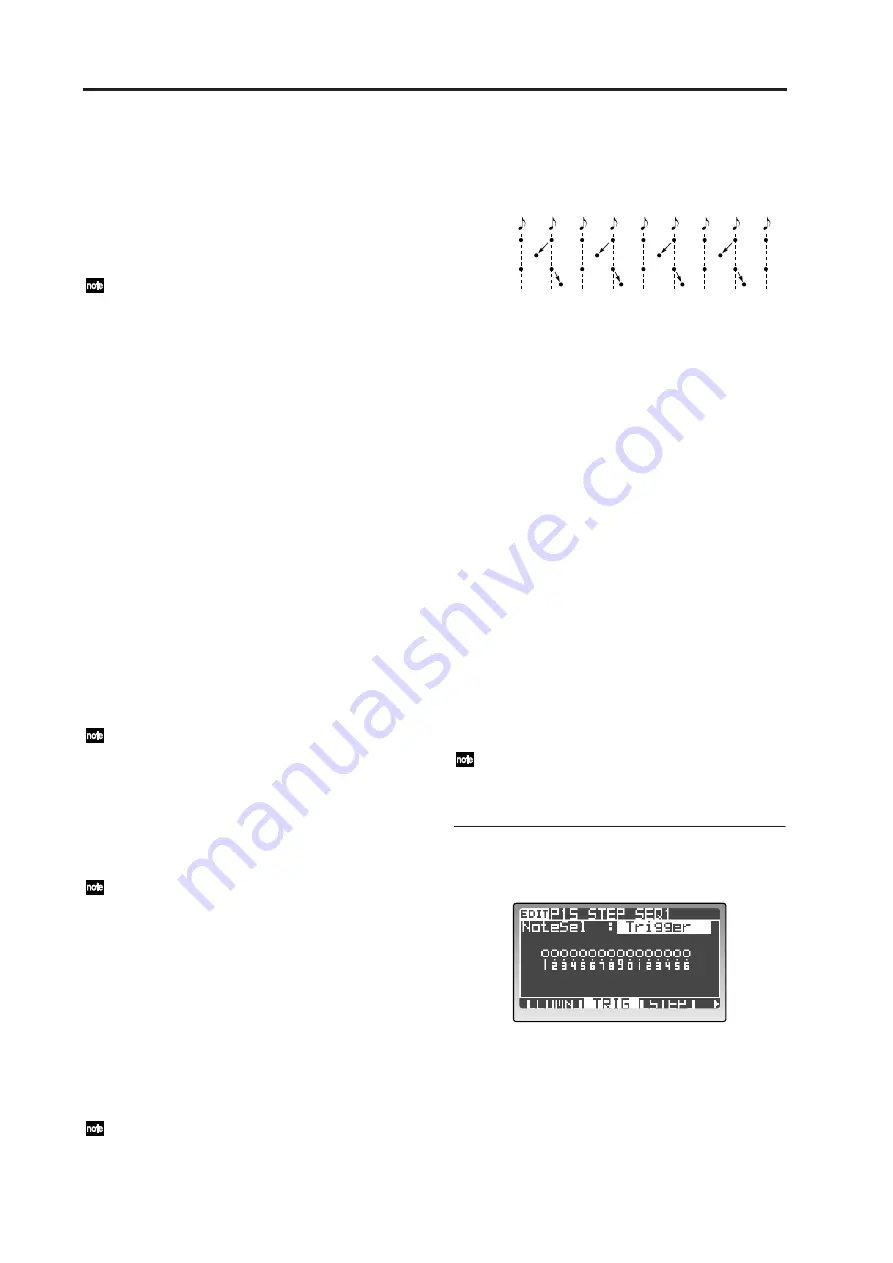
Program parameters
100
Loop
The recorded sequence data will play as a loop as long
as you hold down a note.
Step
Each time you press a note, only one step of the recorded
sequence data will play and then advance to the next
step. Playback will stop when you release all notes being
held.
Since the playback for Step is gated by the key-
board, the front panel [LATCH] button and
[GATE] knob settings and the settings of the “Gate
Time” and “Swing” parameters will be ignored.
3: Resolutn (Resolution)
[
1/32…
1/1]
Specifies the resolution (spacing) relative to the tempo
specified by “Tempo.” Each step of the sequence will
sound at timing intervals of this note value relative to
the tempo. For example if you specify
1/4, each step
will sound at quarter-note intervals of the tempo.
4: Transpose
[Off, On]
Specifies whether the playback pitch of step sequencer 1
will change according to the key you press.
If this is On, the pitch of the notes will change in corre-
spondence to the distance from the “Base Note” at
which you press a key. For example if you press a key a
semitone below the “Base Note,” the sequence will play
back one semitone below its recorded pitch. This setting
is suitable for a pitched sequence pattern such as a bass
pattern or chords.
If this is Off, the sequence will always play back at the
same pitches. This setting is suitable for drum pattern
sequences.
Use “ScanBotom” and “ScanTop” to specify the
range of notes that will trigger the step sequencer.
5: BaseNote
[C-1…G9]
Specifies the base note number used when playing step
sequencer 1. For example if this is set to C4, the sequence
will play at its recorded pitch when you press the C4
note.
When you finish recording into the step sequenc-
er, the “BaseNote” value is automatically set to the
lowest note played in the recorded data.
6: GateTime (Gate Time Offset)
GATE
[–100…+100]
Specifies an offset to the gate time (the duration of each
note). This adjusts the gate time for each step that is
specified in the P15–3: STEP SEQ1 – STEP tab page
(
p.102), giving you an additional way to vary the per-
formance.
Positive (+) settings make the gate time longer, and neg-
ative (–) settings make the gate time shorter.
When the step sequencer is playing, you can use
the front panel [GATE] knob to control the gate
time in realtime.
7: Swing
[–100…+100 %]
Adjusts the timing of the even-numbered notes in the
step sequencer playback.
8: ScanBotom (Scan Bottom)
[C-1…G9]
9: ScanTop (Scan Top)
[C-1…G9]
These specify the region of notes that will trigger play-
back for step sequencer 1. “ScanBottom” specifies the
bottom note of the region, and “ScanTop” specifies the
top note. The step sequencer will play when you press a
note within this region.
10: S.SeqLink (Sequencer Link)
[Off, On]
Specifies whether step sequencer 1 and step sequencer 2
will be linked.
Off
Step sequencer 1 and step sequencer 2 will function in-
dependently.
On
Step sequencer 1 and step sequencer 2 will be linked.
This will create a sequencer of up to 64 steps. You will be
able to record up to 64 steps.
The sequence data always plays in the order of sequenc-
er 1 and then sequencer 2. If you want playback to start
from sequencer 2, use the P16–5: UTILITY – ARP tab
page “SwapStepSeq” operation to exchange the se-
quence data. (
With the exception of “BaseNote,” the settings of
sequencer 1 will take priority when the two se-
quencers are linked.
P15–2: TRIG (STEP SEQ1 Trigger)
In the P15–2: STEP SEQ1 – TRIG tab page you can turn
each step on or off.
1: NoteSel (Note Select)
[Trigger, Drum01…Drum16, C-1…G9]
Specify the type of notes you want to edit. The step on/
off indication shown below will change depending on
the type of note you specify.
When the Resolution is 1/8
1
2
3
4
5
6
7
8
9
Swing –50
Swing +25
Summary of Contents for MMT RADIAS
Page 1: ...2 E Owner s Manual...
Page 6: ...Table of Contents vi...
Page 7: ...Operation Introduction Front and rear panels Setup Quick Start Editing...
Page 78: ...Editing 72...
Page 79: ...Parameter Program parameters Drum parameters Global parameters Effect guide...
Page 150: ...Effect guide 144...
Page 151: ...Appendices...






























